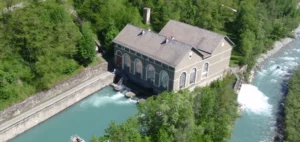Grand’Maison, France’s most powerful hydroelectric dam, has been generating electricity for decades, but is now also called upon to absorb peaks in consumption or overproduction linked to the rise of intermittent renewable energies.
STEP: The essential mechanism to support the growth of green energies
It’s a feat of engineering: the water released by the dam slopes gently through 7 km of underground tunnels, before joining a 1,000-metre-high vertical conduit that hurls it at 400 km/h into the power plant’s turbines. Enough to supply 750,000 people with electricity. But then some of the water takes the exact opposite route, pushed by reversible turbines that return it to the upstream reservoir at an altitude of 1,700 m.
“We’re replenishing the +battery’s+ stock,” sums up Maxime Pradel, operations coordinator at the Isère site.
These unusual dams, also known as “STEP” (stations d’énergie par pompage turbinage), are based on a long-established principle and are today the main means of storing electricity. Long before lithium-ion batteries. Storage will be an increasingly strategic issue when it comes to integrating renewable energies, such as solar and wind power, which are by nature intermittent and booming.
All the energy scenarios for 2050 devised by the high-voltage grid operator RTE are based on the development of these STEPs (8 gigawatts) to offer greater flexibility. Worldwide too, STEPs are taking the lion’s share of storage capacity, according to the International Energy Agency (IEA), with 200 GW expected by 2026, three times more than batteries…
France and its six hydroelectric power stations: Focus on Grand’Maison at 1.8 GW
France currently has six such plants, with a total installed capacity of 5 GW. And Grand’Maison, at 1.8 GW, is the most powerful in Europe, claims EDF. – 56,000 pools – On the site commissioned in 1985-87, everything is gigantic. Located high up in the Oisans mountains, where in winter maintenance workers can only get there by helicopter, the upstream reservoir on the Eau d’Olle river holds 140 million m3 of water (56,000 Olympic-sized swimming pools!). Thanks to the spring rains, this year it is 94% full (78% last year).
The rockfill dam, monitored by 300 sensors, is this morning being examined through binoculars by Nicolas Muller, who is in charge of monitoring the structures. “We’re looking at the stability of the banks, where the layers of friable lias meet the crystalline bedrock,” he says, before setting off to explore 10 km of service galleries leading to the sluice gates in particular. The book is “doing very well”, he assures us.
Ten kilometers further down the valley, at the Grand’maison plant, 12 groups of turbines, 15 m high and mostly installed underground, convert mechanical energy into electricity. One has just been completely dismantled, a first.
The growing challenge of STEPs with renewable energies: Grand’Maison’s innovation
The aim is to “assess all its components” after 40 years of operation, explains Mr Pradel. “The plant is very busy,” he says, with 8,000 cycles in a year. “We can bring up 1,300 MW of energy, and thus make large-scale storage. We also know how to adjust according to needs, and make a few MW”.
Remote-controlled from Lyon, Grand’Maison responds to morning and evening consumption peaks by generating more electricity. Conversely, when there’s too much production on the grid, for example from renewables, or at night, “we take advantage of this to pump water back up” – because pumping water in turn requires a lot of energy.
With renewable energies, “the challenge of STEPs is becoming increasingly important”, and Grand’Maison has had to innovate, explains Maxime Pradel, notably by increasing the power of its turbines by 14 MW.
Today, EDF says it is capable of building an additional 3 GW of STEPs, without disclosing the overall investment amount, between a legal unknown linked to an old dispute with Brussels and major financing needs for other projects. Among its projects is a 460 MW power plant incorporating new turbines but using the basins of the existing Montézic WWTP (Aveyron), a potential investment of over 500 million euros.






















